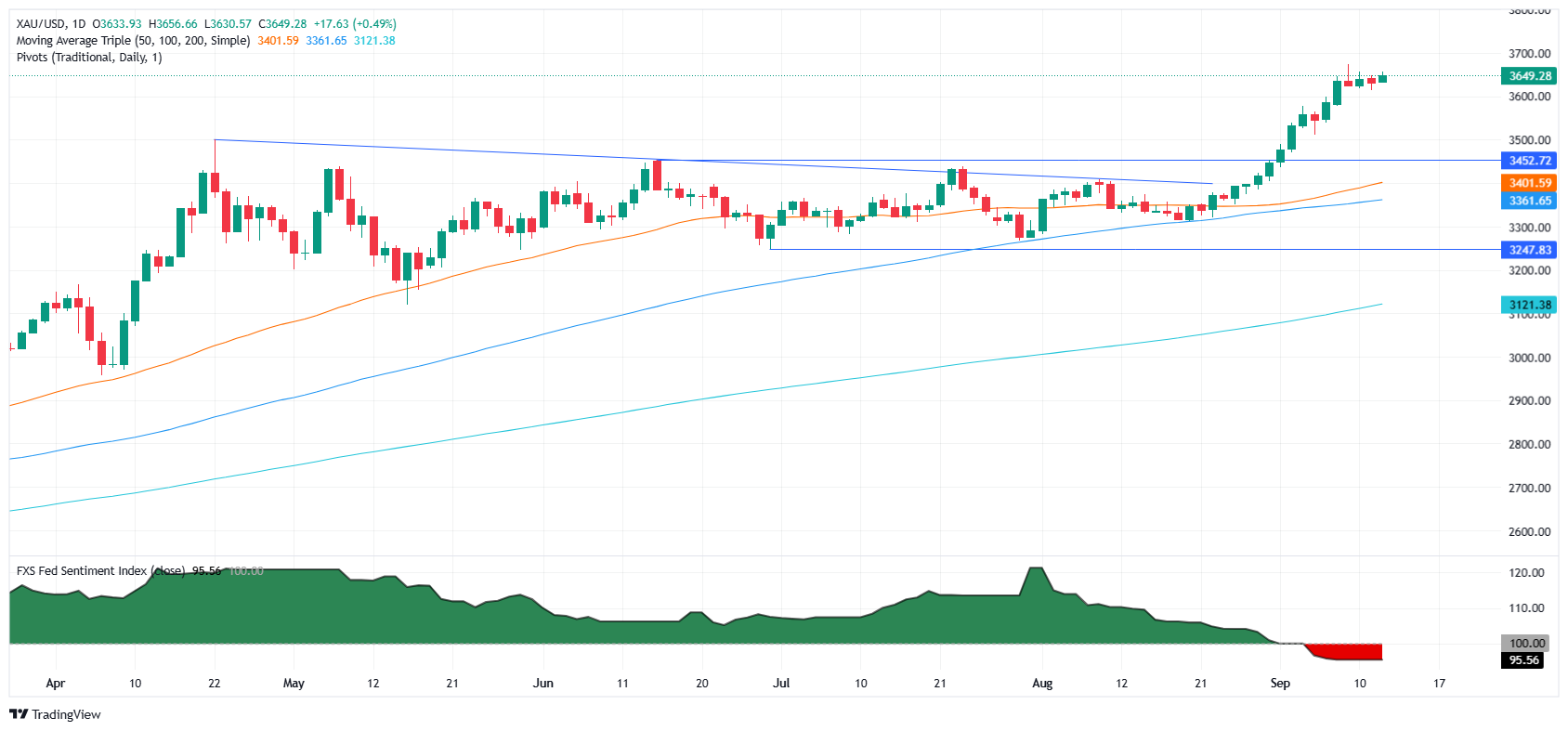Gold rises as weak US sentiment and jobs data fuel rate cut expectations
- Gold rebounds after weak UoM sentiment and soft jobs data boost rate cut bets.
- Payroll revision and rising Jobless Claims outweigh steady inflation prints earlier in the week.
- Geopolitical tensions and looming 25 bps Fed cut keep safe-haven demand strong ahead of September SEP.
Gold prices rise over 0.44% during Friday’s North American session as weaker than expected jobs market data increased the chances that the Federal Reserve (Fed) will cut interest rates next week. At the time of writing, XAU/USD trades at $3,649 after hitting a daily low of $3,630.
Bullion rises on weak Consumer Sentiment, Jobless Claims boost Fed easing bets
The week ended with a softer than expected University of Michigan (UoM) Consumer Sentiment for September, while 5-Year inflation expectations surged. Friday’s data along with Tuesday’s -911K payroll revision, and an increase in people filing for unemployment benefits in the US, outweighed inflation data released during the week.
The data has cemented the case for the first rate cut to come next week at the Federal Open Market Committee (FOMC) meeting on September 17. Three weeks ago, Fed Chair Jerome Powell's Jackson Hole speech opened the door for interest rate adjustments while acknowledging that the labor market was cooling faster than expected.
Next week, the Fed is likely to cut rates by 25 basis points and clarify future policy through the latest Summary of Economic Projections (SEP).
Geopolitical tensions are supporting higher Gold prices. US President Donald Trump said that he is running out of patience with Russian President Vladimir Putin and threatened to impose “very hard” sanctions on the country.
Daily market movers: Gold remains underpinned despite rising US yields
- The UoM Consumer Sentiment poll showed that Americans are growing less optimistic about the economy, as the Consumer Sentiment Index dipped from 58.2 to 55.4. Inflation expectations for one year were unchanged at 4.8%, while for five years they rose from 3.5% to 3.9%.
- Banks like Deutsche Bank expect the Fed to cut interest rates by 25 bps in all three remaining meetings this year, meaning that the fed funds rate will reach the 3.50%-3.75% range before the new year.
- US consumer inflation held steady, with headline Consumer Price Index (CPI) remaining below the 3% mark. Meanwhile, Initial Jobless Claims for the week ending September 6 climbed to their highest level in nearly four years, underscoring persistent weakness in the labor market.
- The US Dollar Index (DXY), which tracks the buck’s performance against a basket of six currencies, recovers, up 0.10% at 97.59.
- US Treasury yields are surging, with the 10-year Treasury note up four basis points (bps) to 4.068%. US real yields — calculated by subtracting inflation expectations from the nominal yield — rose nearly four-and-a-half basis points to 1.728% at the time of writing.
- The Bureau of Labor Statistics (BLS) revised down its annual benchmark payrolls to -911K for March 2025, exceeding economists’ estimates of -682K.
- The Prime Market Terminal interest rate probability tool shows odds for a 25 bps of Fed easing at 91% on September 17, and a slim chance of 9% for a 50 bps rate cut.
Technical outlook: Gold price edges toward $3,650 as bulls target record high
Gold prices are consolidating for a third consecutive session after notching a record high of $3,674 on September 9. The Relative Strength Index (RSI) is flashing overbought signals, suggesting limited room for further upside in the near term.
A break above $3,650 would put the ATH back in play, with $3,700 as the next target. Beyond that, bulls target $3,750 and $3,800. On the downside, a drop below $3,600 would expose support at $3,550, followed by the April 22 high at $3,500.

Gold FAQs
Gold has played a key role in human’s history as it has been widely used as a store of value and medium of exchange. Currently, apart from its shine and usage for jewelry, the precious metal is widely seen as a safe-haven asset, meaning that it is considered a good investment during turbulent times. Gold is also widely seen as a hedge against inflation and against depreciating currencies as it doesn’t rely on any specific issuer or government.
Central banks are the biggest Gold holders. In their aim to support their currencies in turbulent times, central banks tend to diversify their reserves and buy Gold to improve the perceived strength of the economy and the currency. High Gold reserves can be a source of trust for a country’s solvency. Central banks added 1,136 tonnes of Gold worth around $70 billion to their reserves in 2022, according to data from the World Gold Council. This is the highest yearly purchase since records began. Central banks from emerging economies such as China, India and Turkey are quickly increasing their Gold reserves.
Gold has an inverse correlation with the US Dollar and US Treasuries, which are both major reserve and safe-haven assets. When the Dollar depreciates, Gold tends to rise, enabling investors and central banks to diversify their assets in turbulent times. Gold is also inversely correlated with risk assets. A rally in the stock market tends to weaken Gold price, while sell-offs in riskier markets tend to favor the precious metal.
The price can move due to a wide range of factors. Geopolitical instability or fears of a deep recession can quickly make Gold price escalate due to its safe-haven status. As a yield-less asset, Gold tends to rise with lower interest rates, while higher cost of money usually weighs down on the yellow metal. Still, most moves depend on how the US Dollar (USD) behaves as the asset is priced in dollars (XAU/USD). A strong Dollar tends to keep the price of Gold controlled, whereas a weaker Dollar is likely to push Gold prices up.

